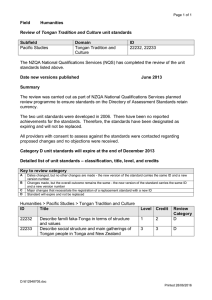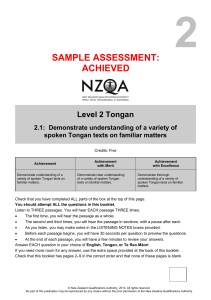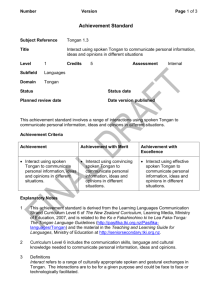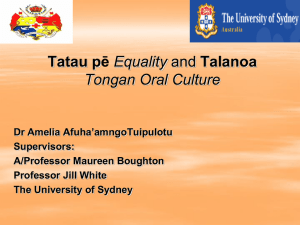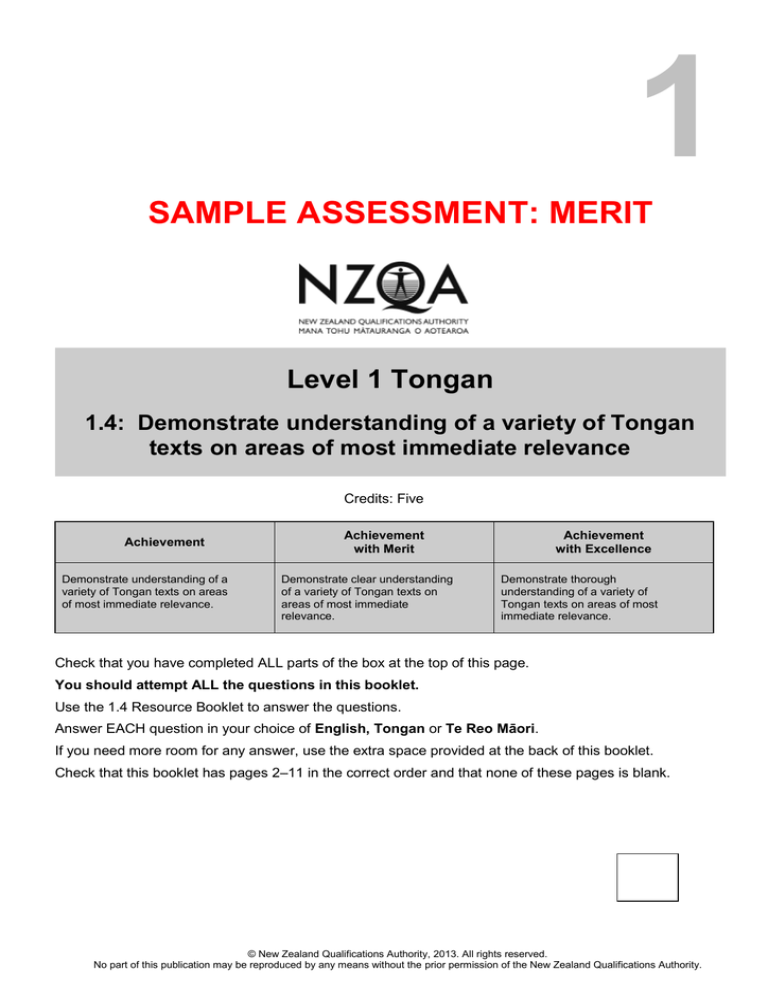
1
SAMPLE ASSESSMENT: MERIT
Level 1 Tongan
1.4: Demonstrate understanding of a variety of Tongan
texts on areas of most immediate relevance
Credits: Five
Achievement
Demonstrate understanding of a
variety of Tongan texts on areas
of most immediate relevance.
Achievement
with Merit
Demonstrate clear understanding
of a variety of Tongan texts on
areas of most immediate
relevance.
Achievement
with Excellence
Demonstrate thorough
understanding of a variety of
Tongan texts on areas of most
immediate relevance.
Check that you have completed ALL parts of the box at the top of this page.
You should attempt ALL the questions in this booklet.
Use the 1.4 Resource Booklet to answer the questions.
Answer EACH question in your choice of English, Tongan or Te Reo Māori.
If you need more room for any answer, use the extra space provided at the back of this booklet.
Check that this booklet has pages 2–11 in the correct order and that none of these pages is blank.
© New Zealand Qualifications Authority, 2013. All rights reserved.
No part of this publication may be reproduced by any means without the prior permission of the New Zealand Qualifications Authority.
2
Ngāue‘aki ‘a e houa ‘e taha ke tali ‘a e ngaahi fehu‘i ‘i he pepa ni.
You are advised to spend one hour answering the questions in this booklet.
FIRST TEXT: Ko e feohi fakalata atu
Lau ‘a e talanoa ‘uluaki mei he peesi 2 ‘o e pepa talanoa pea tali ‘a e Fehu‘i ‘Uluaki.
Read the text on page 2 of the resource booklet. Use it to answer Question One.
FEHU‘I ‘ULUAKI – QUESTION ONE
(a)
Talamai ha fakalata ‘e ua ‘o e fetaulaki ‘a e ngaahi kaungāme‘a.
Give two reasons why these friends enjoyed their get together.
‘Uhinga 1 / Reason 1
Seeing other friends from other schools.
‘Uhinga 2 / Reason 2
Sharing stories and ideas about their lives.
(b)
Ko e hā ha ‘uhinga ‘e ua na‘e makehe ai ‘a e polo fakaako ‘a Mele he ta‘u ni?
What were two of the highlights at Mele’s school ball this year?
Fakatātā 1 / Example 1
Ana’s partner for the ball was her new boyfriend.
Fakatātā 2 / Example 2
The excitement of seeing students coming to the ball in a limo.
(c)
Ko e hā ne kaaimu‘a hake ai ‘a Paula ‘oku te‘eki ai ke ‘osi e talanoa ‘a Mele?
Why did Paula interrupt Mele’s story?
He was so excited to share his story and was unwilling to wait for Mele to finish her
story.
Tongan 1.4 Sample assessment: Merit
Ke
ngāue‘aki
pē ‘e he
fai sivi
Assessor’s
use only
3
(d)
Ko e hā ne vetengata‘a ai ‘enau talanoa? ‘Omai ha ‘uhinga ‘e tolu ‘o fakatatau ki ho‘o ‘ilo‘i
e talanoa.
In your opinion, why was it so difficult for the friends to stop their conversation? Give three
reasons to support your answer.
‘Uhinga 1 / Reason 1
Lack of time before games start.
‘Uhinga 2 / Reason 2
Each one has a story to share.
‘Uhinga 3 / Reason 3
They come from different schools and only have the chance once a week.
Tongan 1.4: Sample assessment: Merit
Ke
ngāue‘aki
pē ‘e he
fai sivi
Assessor’s
use only
4
SECOND TEXT: Ko e faiva faka-Tonga
Sio ki he fakatātā ‘i he peesi 3 pea ngāue‘aki ia ke tali ‘a e Fehu‘i Ua.
Look at the image on page 3 of the resource booklet. Use it to answer Question Two.
FEHU‘I UA – QUESTION TWO
(a)
Talamai ha me‘a ‘e tolu ‘oku ke sai‘ia ai ‘i he fakatātā ko ‘eni.
List three reasons why you like this picture.
‘Uhinga 1 / Reason 1
The quality of the Tongan dance.
‘Uhinga 2 / Reason 2
The way the performers were dressed reflects our Tongan culture.
‘Uhinga 3 / Reason 3
The performers’ facial expressions reflect happiness.
(b)
Ko e hā ha me‘a ‘e tolu mei he fakatātaa ‘oku ne talamai hotau anga faka-Tonga.
Name three things you can see in the picture that tell you about Tongan culture.
Fakatātā 1 / Example 1
Group effort is reflected by the presence of both parents and students.
Fakatātā 2 / Example 2
Tongan dancing costumes are unique and colourful.
Fakatātā 3 / Example 3
Tongan performance is always graceful.
Tongan 1.4: Sample assessment: Merit
Ke
ngāue‘aki
pē ‘e he
fai sivi
Assessor’s
use only
5
(c)
Talamai ha ‘ulungaanga lelei ‘e tolu ‘oku ke fakatokanga‘i mei he fakatātaa.
Give three moral lessons you can learn from the picture.
Lēsoni 1 / Lesson 1
Happiness is the best.
Lēsoni 2 / Lesson 2
Working as a team.
Lēsoni 3 / Lesson 3
To share and care is supporting one another.
(d)
Ko e hā ‘oku mahu‘inga ai ‘a e kau mai ‘a e mātu‘a he ngaahi faiva fakaako?
Why is it important for parents to be part of Secondary Schools ASB Polyfest?
They are important ambassadors in the learning of culture in schools.
Tongan 1.4: Sample assessment: Merit
Ke
ngāue‘aki
pē ‘e he
fai sivi
Assessor’s
use only
6
THIRD TEXT: Ko hoku fāmili
Lau ke mahino ‘a e tohi hohoko fakafāmili ‘i he peesi 4 ‘o e pepa talanoa pea ke ngāue‘aki ia ke
tali ‘a e Fehu‘i Tolu.
Study the family tree on page 4 of the resource booklet. Use it to answer Question Three.
FEHU‘I TOLU – QUESTION THREE
(a)
Na‘e toko fiha ‘a e fanga makapuna ‘uluaki ‘o Mele?
How many first grandchildren did Mele have?
Five grandchildren.
(b)
Ko hai he tama ‘a Mele na‘e ‘ikai hano hako?
Who did not have any children?
Sioeli was the one.
(c)
Talamai ange ha ‘uhinga ‘e ua ki he ‘ikai ha hako ‘o e taha he fānau ‘a Mele?
Why was it that one of Mele’s children did not have any children?
‘Uhinga 1 / Reason 1
He was not married.
‘Uhinga 2 / Reason 2
He died young.
Tongan 1.4: Sample assessment: Merit
Ke
ngāue‘aki
pē ‘e he
fai sivi
Assessor’s
use only
7
(d)
Tā ha fakatātā ‘o e hokohoko homou fāmili. Kamata mei ho‘o kui ‘o ha‘u ai ki ho‘o mātu‘a
pea a‘u mai kia koe. ‘Oku ‘atā pē ke ke fakakau mai ai ho‘o ngaahi fa‘ētangata mo
mehekitanga.
Draw your own family tree. Include your parents and siblings (brothers and sisters). You may
also include grandparents and cousins, depending on the size of your family.
(Individual family tree diagram here.)
Tongan 1.4: Sample assessment: Merit
Ke
ngāue‘aki
pē ‘e he
fai sivi
Assessor’s
use only
8
FOURTH TEXT: Fakalakalaka ‘o e tekinolosia
Sio ki he ngaahi fakatātā ‘i he peesi 5 ‘o e pepa talanoa. Ngāue‘aki ia ke tali ‘a e Fehu‘i Faa.
Look at the images on page 5 of the resource booklet. Use them to answer Question Four.
FEHU‘I FĀ – QUESTION FOUR
(a)
Talamai ha ngaahi me‘a ‘e tolu he fakatātaa ‘oku tokoni ke vave ange ai ‘a e fetu‘utaki.
Name three things from the photos that improve communication.
Fakatātā 1 / Example 1
Home phone.
Fakatātā 2 / Example 2
Cell phone.
Fakatātā 3 / Example 3
Computers.
(b)
Ko e hā ha tokoni ‘e ua ‘a e ngaahi tekinolosia ko ‘eni ke toe vāofi ange ai ‘etau fetu‘utaki
mo hotau ngaahi fāmili?
What are two of the advantages of having new technology when it comes to communicating
with our families?
‘Uhinga 1 / Reason 1
It is much cheaper.
‘Uhinga 2 / Reason 2
It is easier to use.
Tongan 1.4: Sample assessment: Merit
Ke
ngāue‘aki
pē ‘e he
fai sivi
Assessor’s
use only
9
(c)
Ko e hā ha palopalema ‘oku fakatupu ‘e he ngaahi tekinolosia ko ‘eni?
What are some of the problems that new technology brings?
Ako / Study
It causes distractions for students.
Fāmili / Family
Creates financial issues.
Siaisi / Church
Greater demands to improve the use of technology in church.
(d)
Fili mai ha taha mei he ngaahi fakatātaa ni ‘oku ke pehē ‘oku pau mo malu taha ke
ngāue‘aki ‘e ho fāmili. Talamai ha ‘uhinga ‘e tolu ki ho‘o fili.
Select what you consider to be the best means of communication from text 4.
Cell phone.
Give three reasons why you think it is the best kind for you and your family.
Fakatātā 1 / Example 1
Easy to take with you everywhere you go.
Fakatātā 2 / Example 2
Family members can use it to call each other.
Fakatātā 3 / Example 3
Pay less to contact other family members.
Tongan 1.4: Sample assessment: Merit
Ke
ngāue‘aki
pē ‘e he
fai sivi
Assessor’s
use only
10
Konga ‘oku ‘atā ‘o ka fiema‘u.
Extra space if required.
Tohi ‘a e fika ‘o e fehu‘i ‘o ka fiema‘u.
Write the question number(s) if applicable.
Fika ‘o e
fehu‘i
Question
number
Tongan 1.4: Sample assessment: Merit
Ke
ngāue‘aki
pē ‘e he
fai sivi
Assessor’s
use only
11
Konga ‘oku ‘atā ‘o ka fiema‘u.
Extra space if required.
Tohi ‘a e fika ‘o e fehu‘i ‘o ka fiema‘u.
Write the question number(s) if applicable.
Fika ‘o e
fehu‘i
Question
number
Tongan 1.4: Sample assessment: Merit
Ke
ngāue‘aki
pē ‘e he
fai sivi
Assessor’s
use only




